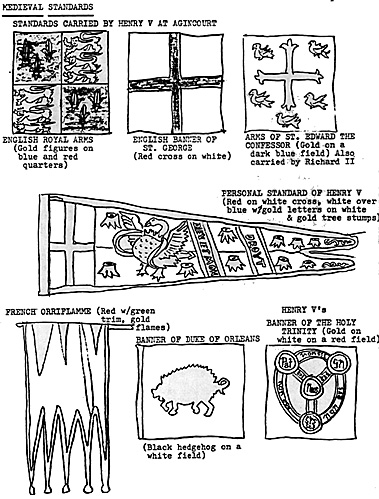Orders were fairly simple in the Dark Ages as far as Western European armies went. Such shouted commands as "Close and fight! Close! Close!" or "Spur your horses and advance at a walk!" were interspersed with "God Almighty" and similar religious cantations. Thus the banner was of paramount importance to not only morale and army cohesion, but to signals and order giving as well.
Medieval and Dark Ages battles were not just boring clashes of opposing close order shield-walls. Anyone who has researched the period can appreciate the tactical skill and cunning which determined the outcome of such battles as Bouvines, Thielt and Hastings. It is obvious that in an age where radio messages were non-existant, that a shouted command would not carry very far, even if repeated ... and with each repetition the original order would become less coherent. The standard, supplemented by various horn and/or drum sounds, were the primary signals used in this era of organized warfare.
The banner was the symbol of continued battle, a sure sign that the general or leader was still alive and fighting on and not (as we've all seen) hiding in the rear somewhere. Basically, the warriors fought as long as the standard was aloft -- but once it fell, this was the signal for all to honorably run for their lives. For the knight especially, it was totally opposed to his training and morale concepts(!) to leave the field unless the general had called it quits. Unless badly wounded himself, there was simply no excuse for not fighting to the end -- and those who chose to save their lives through flight faced a life of dishonor and scorn.
If the standard was seen to fall or be lost, the troops would have the signal to run for it and defeat was usually not only terribly bloody for the loser, but total as well. Because of this, some generals carried a second banner as a back-up in case the first should fall. This reserve would be kept flying as long as he was alive and well.
For melee situations, the standard was the rallying point for troops to reassemble around. The examples of Thielt and Mons-en-Pevele show us that on signal, the knights feigned a rout until outdistancing pursuit. Then they quickly regrouped and charged the now disordered pursuers. How realistic or authentic this is ... well ... but it in mentioned in contemporary and semi-period battle reports and thus holds some weight. Any of our current house rules should have a major provision for use of the standard in our Dark Ages battles.

Back to Saga v2n4 Table of Contents
Back to Saga List of Issues
Back to MagWeb Master Magazine List
© Copyright 1986 by Terry Gore
This article appears in MagWeb.com (Magazine Web) on the Internet World Wide Web. Other articles from military history and related magazines are available at http://www.magweb.com